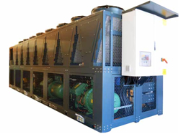Cool-Therm has installed a high efficiency low temperature process cooling chiller with heat recovery at a leading metal finishers, enabling the company to increase production while saving around 40 per cent on its cooling energy bill.
 Cool-Therm has installed a high efficiency low temperature process cooling chiller with heat recovery at a leading metal finishers, enabling the company to increase production while saving around 40 per cent on its cooling energy bill.
Cool-Therm has installed a high efficiency low temperature process cooling chiller with heat recovery at a leading metal finishers, enabling the company to increase production while saving around 40 per cent on its cooling energy bill.
The end user, which specialises in high-tech surface treatments for engineering, commissioned the new cooling plant as part of a replacement and upgrade project at its UK processing facility.
The new system is based on a Geoclima GHA low temperature chiller, which combines high performance screw compressors and EC axial fans. The chiller is used to cool acid as part of an electroplating process.
The corrosive environment had taken its toll on the previous chiller, and a temporary chiller had been installed until a permanent solution could be designed, built and commissioned.
An additional key requirement was to increase cooling capacity, as part of a planned expansion in production at the site. This required cooling capacity of at least 240kW, with a strict electrical load limit of 200A due to limitations on power at the site.
Cool-Therm consultants worked closely with the customer on a design to meet the brief. The chiller had to supply water at -10deg C to a holding tank with very smooth and constant delivery, requiring very accurate pump and tank water level control.
A further requirement was automatic peak-limiting of electrical load to ensure power consumption never exceeded the site limit. The client also specified remote monitoring and heat recovery for use in heating the factory, as part of a drive to reduce energy costs.
Once the design was agreed, tests were carried out by a combined team from Cool-Therm and the end users, to ensure the proposed solution would deliver the conditions required and perform as anticipated from day one.
The chiller was installed in a staged process. The complex water pipework from the chiller to the tank, and the tank to the manufacturing process, was completed in a fast-track procedure over a long weekend to avoid any loss of production. To help meet the challenging deadline, Cool-Therm used a pre-insulated ABS pipework system.
The primary pump is housed within and controlled by the chiller, and maintains the chilled water level in buffer tanks with mm accuracy. Delivering the requirement to achieve 245kW of cooling capacity while keeping within the 200A full load limit was achieved through a combination of enhanced control and technology.
Rob Young, who headed the project for Cool-Therm, says: “We overcame the power limiting factor by adapting control of the compressor’s slide loading mechanism via current rather than position. This, coupled with the use of a generously sized condenser coil, enabled us to deliver the capacity headroom while remaining within the load limit.”
It is believed to be the first project of its kind with such a highly variable flow evaporator and primary water circuit based on screw compressor technology.